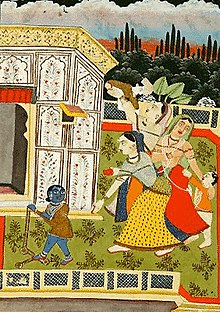Rohini (wife of Vasudeva)
In Hinduism, Rohini (Sanskrit: रोहिणी, rohiṇī) is the first consort of Vasudeva and mother of the Hindu god Balarama and Subhadra. She played a prominent role in the nurture of Krishna.[1][2]
| Rohini | |
|---|---|
 Rohini Devi with Balarama (right) | |
| Personal information | |
| Spouse | Vasudeva |
| Children | Balarama, Subhadra |
Life
Rohini is described as the daughter of king Bahlika. She is married to the Yadava prince Vasudeva.[3]
Vasudeva also married Devaki, the princess of Mathura. The couple was imprisoned by Devaki's brother Kansa, soon after their marriage as a divine prophesy predicted Kansa's death by Devaki's eighth son.
While Vasudeva is imprisoned, Rohini lives at the house of his cousin Nanda in Vraja. While all previous sons of Devaki are slain, the seventh embryo is transferred to Rohini's womb. Rohini gives birth to Balarama.[3]
Krishna, the eighth child of Devaki, was exchanged with the girl child of Nanda and Yashoda in secrecy. Yashoda (foster-mother of Krishna) and Rohini play an important nurturing Krishna and Balarama in their childhood.[3]
After Vasudeva is freed by Krishna and Balarama, Rohini gives birth to a daughter Subhadra, the avatar of goddess Yoganidra.[4]
In the epic Mahabharata, after the death of Vasudeva after the Yadava massacre, Rohini cremates herself on Vasudeva's pyre along with his other wives Devaki, Bhadra and Madira.[5]
Mother of Balarama
Balarama is given the matronymic epithet Rauhineya, "son of Rohini". In the Brahma Vaivarta Purana, Rohini is said to be an avatar of Kadru, mother of the serpents (naga); Balarama is considered an avatar of the divine naga Shesha.[3]
In Jain texts
In Jain tales related to Krishna and Balarama, Rohini is the princess of Kosala who chooses Vasudeva as her husband in a Swayamvara ceremony. She spends her life in Saurapura with Vasudeva, where she gives birth to Balarama. She sees four dreams in the Jain narrative: a lion, a white elephant, the moon and the ocean; symbols associated with Balarama in Hinduism as well as Jainism. Rohini plays no part in nurturing Krishna in Vraja; she takes care of Balarama in Saurapura. The adult Balarama goes to Vraja to aid Krishna.[3]
References
- Flueckiger, Joyce Burkhalter (2013). When the World Becomes Female: Guises of a South Indian Goddess. Indiana University Press. ISBN 978-0-253-00960-9.
- Patel, Vijay (2011). Corrupt Practice. AuthorHouse. ISBN 978-1-4567-9304-3.
- Vemsani, Lavanya (2016). "Rohini". Krishna in History, Thought, and Culture: An Encyclopedia of the Hindu Lord of Many Names. ABC-CLIO. pp. 233–4. ISBN 978-1-61069-211-3.
- Vemsani, Lavanya (2016). "Nidra". Krishna in History, Thought, and Culture: An Encyclopedia of the Hindu Lord of Many Names. ABC-CLIO. p. 195. ISBN 978-1-61069-211-3.
- "The Mahabharata, Book 16: Mausala Parva: Section 7". Sacred-texts.com. Retrieved 18 July 2018.
